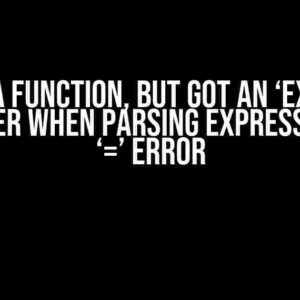Hey there, fellow Developers! Are you tired of dealing with messy code and unclear data structures? Do you want to learn how to express a unique set of value pairs in TypeScript like a pro? Well, you’re in luck because today, we’re going to dive into the world of TypeScript and explore the different ways to achieve this.
What are Value Pairs, and Why do we need them?
Before we dive into the solution, let’s take a step back and understand what value pairs are and why we need them. A value pair is a combination of two values that are related to each other. For example, a person’s name and age, a product’s id and price, or a color’s name and hex code. In programming, we use value pairs to represent data in a structured and organized manner.
In TypeScript, value pairs are essential when working with data structures like objects, arrays, and maps. They help us to
- Organize data in a structured way
- Make code more readable and maintainable
- Improve data integrity and consistency
- Enhance code performance and scalability
Methods to Express a Unique Set of Value Pairs in TypeScript
Now that we understand the importance of value pairs, let’s explore the different methods to express a unique set of value pairs in TypeScript. We’ll cover three approaches: using objects, arrays, and maps.
Method 1: Using Objects
In TypeScript, we can use objects to represent a unique set of value pairs. An object is a collection of key-value pairs where each key is unique and maps to a specific value.
interface Person {
name: string;
age: number;
}
const person: Person = {
name: 'John Doe',
age: 30
};
In the above example, we defined an interface `Person` with two properties: `name` and `age`. We then created an object `person` that implements the `Person` interface. This approach is useful when we need to represent a small number of value pairs.
Method 2: Using Arrays
Another way to express a unique set of value pairs is by using arrays. In TypeScript, we can use a tuple type to represent an array of value pairs.
type Color = [string, string];
const colors: Color[] = [
['red', '#FF0000'],
['green', '#00FF00'],
['blue', '#0000FF']
];
In the above example, we defined a type `Color` as a tuple of two strings. We then created an array `colors` that contains multiple `Color` tuples. This approach is useful when we need to represent a large number of value pairs.
Method 3: Using Maps
The third approach is to use maps, which are also known as dictionaries or hash tables. In TypeScript, we can use the `Map` type to represent a unique set of value pairs.
const personMap = new Map([
['John Doe', 30],
['Jane Doe', 25],
['Bob Smith', 40]
]);
console.log(personMap.get('John Doe')); // Output: 30
In the above example, we created a `Map` object `personMap` that stores a unique set of value pairs. We can use the `get` method to retrieve a value by its key. This approach is useful when we need to frequently look up values by their keys.
Best Practices for Working with Value Pairs in TypeScript
Now that we’ve covered the different methods to express a unique set of value pairs in TypeScript, let’s discuss some best practices to keep in mind:
- Use meaningful property names: When using objects or maps, use meaningful property names that describe the value pair.
- Use consistent data types: Ensure that the data types of the value pairs are consistent throughout your code.
- Avoid duplicate keys: When using objects or maps, avoid duplicate keys to prevent data inconsistencies.
- Use type annotations: Use type annotations to specify the data type of the value pairs, which helps with code readability and maintainability.
- Validate data: Validate the data when creating or updating value pairs to ensure data integrity.
Conclusion
In conclusion, expressing a unique set of value pairs in TypeScript is crucial for maintaining clean, readable, and scalable code. By using objects, arrays, or maps, we can represent data in a structured and organized manner. Remember to follow best practices, such as using meaningful property names, consistent data types, and validating data, to ensure that your code is maintainable and efficient.
So, the next time you’re working with value pairs in TypeScript, remember the methods and best practices we covered in this article. Happy coding!
| Method | Description | Use Case |
|---|---|---|
| Objects | Represent a small number of value pairs | Config objects, settings, or small data sets |
| Arrays | Represent a large number of value pairs | Large data sets, data collections, or arrays of objects |
| Maps | Represent a unique set of value pairs with frequent lookups | Data caching, configuration, or dictionary-like data structures |
This article has provided a comprehensive guide on how to express a unique set of value pairs in TypeScript. Whether you’re a seasoned developer or a beginner, this article has covered the essential concepts and best practices to help you write clean, readable, and scalable code.
Here are 5 Questions and Answers about “How to express a unique set of value pairs in TypeScript” in a creative voice and tone:
Frequently Asked Question
Stuck on how to express a unique set of value pairs in TypeScript? We’ve got you covered! Here are the answers to your burning questions.
Q1: What’s the best way to define a unique set of value pairs in TypeScript?
You can use a TypeScript interface to define a unique set of value pairs. For example, `interface ValuePairs { [key: string]: string }` defines a type that has string values with unique string keys.
Q2: How do I ensure that each value pair has a unique key in TypeScript?
You can use the `unique symbol` type in TypeScript to ensure that each value pair has a unique key. For example, `interface ValuePairs { [key: unique symbol]: string }` defines a type that has string values with unique symbol keys.
Q3: Can I use enums to express a unique set of value pairs in TypeScript?
Yes, you can use enums to express a unique set of value pairs in TypeScript. For example, `enum ValuePairs { A = ‘a’, B = ‘b’, C = ‘c’ }` defines an enum with unique string values.
Q4: How do I create a type that represents a unique set of value pairs with specific types?
You can use a TypeScript type alias to create a type that represents a unique set of value pairs with specific types. For example, `type ValuePairs = { [key: string]: number | string }` defines a type that has string keys with either number or string values.
Q5: Are there any limitations to expressing unique sets of value pairs in TypeScript?
Yes, there are some limitations to expressing unique sets of value pairs in TypeScript. For example, you can’t use the `unique symbol` type with object literal types, and enums have some limitations when it comes to using them as value pairs.
I hope this helps! Let me know if you need anything else.





